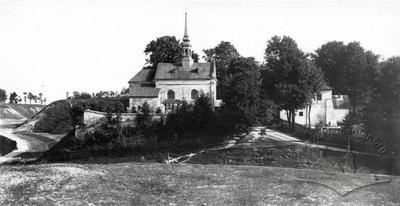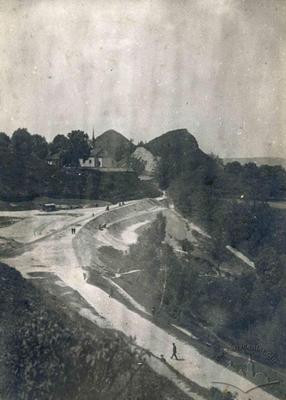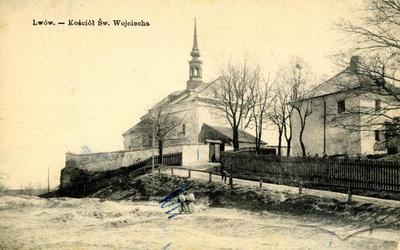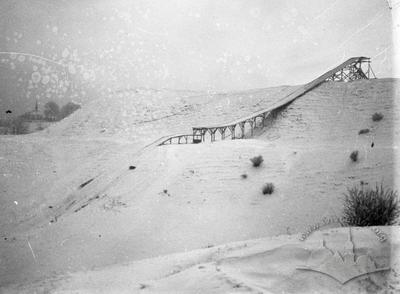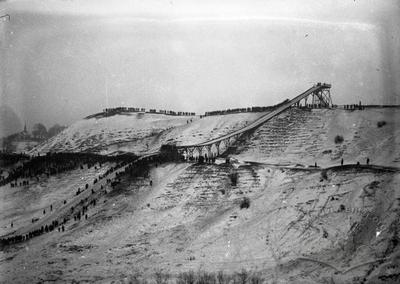Vul. Dovbusha, 24 – former st. Wojciech church ID: 2334
The St. Wojciech church was built by one of the best Lviv constructors, Paolo Romanus, and belongs to the last examples of the Renaissance style in Lviv. According to the resolution of the Regional Executive Committee of the Lviv Region number 393 dated 22 November 1988, the house was entered into the Register of local monuments under protection number 903-M. On 8 September 1996, after a restoration, the church was consecrated in the name of St. Josaphat and All Ukrainian Martyrs; the members of the Milites Christi Imperatoris congregation have settled in the renovated premises of the monastery.
Story
1607 – a church and a
wooden monastery building with a boarding school are built.
1702 – the original
monastery building is replaced with a masonry one.
Late 18th
c. – the
monastery is abolished; the church is closed; a powder magazine is arranged in
the monastery premises.
1897 – the church is given
back to the community, restored and consecrated; the monastery premises are
adapted for a boarding house for the students of the Lviv Roman Catholic
seminary.
1940s - early 1990s – the monastery and
church buildings are occupied by a military unit; the lower parts the church
windows are bricked up.
1993 – the church and the
monastery premises are handed over to the Milites Christi Imperatoris
congregation.
1996 – the church is
consecrated in the name of St. Josaphat and All Ukrainian Martyrs.
2002 – murals are painted
by Mila Mina, a Czech painter.
The monastery complex is situated on a small plot on Dovbusha (earlier Św. Wojciecha) street in a very picturesque neighbourhood. A steep slope of the Zmieva mountain rises to the south of the church and drops down to the east. The north-western slope of the monastery grounds is reinforced with a massive retaining wall supported by buttresses.
The history of the church and monastery remains rather obscure. In his book entitled Leopolis triplex, Bartołomeusz Zimorowicz, a Lviv chronicler, writes about the construction of the church under the year 1607: “The St. Wojciech chapel was built amidst the hills on the following reason. Petro Moskalyk, who lived in the vicinity of the High Castle and lost his children five years ago in the time of pestilence and buried them in a field, placed a monument with a cross on the top of the Leva mountain. Shortly, people began to bury children there, and the place started to be venerated. Relatives, at first, and then the neighbours made a contribution and built a small church where, on permission of the archbishop, a service was celebrated on the patron saint feast day. And as every year the feast of St. Wojciech falls after Easter, the whole place is on that day crowded by the festive community, attracted by a nice spring time; the people think that they also render homage to their patron saint by way of such a congregation.” Historian Dyoniziusz Zubrzycki dates the erection of the church to the same year: “A small church of St. Wojciech was finished and consecrated in this [1607] year; it stands on the slopes of the Leva [Zmiyeva] mountain where a powder magazine is located now over the village of Znesinnia.”
With the course of time, the care of the church was taken over by missionary monks who built a small monastery building with a boarding school there to prepare young clerics for entering the theological seminary. In 1702 the original monastery building was replaced by a masonry one.
According to a legend, during the Swedish siege of the city in 1704 king Karl XII stayed in the monastery.
After Lviv was annexed by the Austrian Empire, the monastery was abolished due to the 1785 decree of Emperor Joseph II. The church was closed and a powder magazine was arranged in the monastery premises. On the 1849 cadastral map of Lviv the monastery is designated as the Imperial and Royal powder magazine no. 3 (K.K. Pulver Depot №III). The monastery grounds are marked with topographical numbers 5794, 5795, and 5796; the buildings are marked with conscription numbers 3045 (St. Wojciech church) and 3044 (monastery). Only in 1897, when the 900th anniversary of St. Wojciech’s death was commemorated, the church was given back to the community, restored and consecrated. A boarding house for the students of the Lviv Roman Catholic seminary was arranged in the monastery premises.
After the World War II and till the early 1990s the monastery and church buildings were occupied by a military unit. At that time the windows became smaller as their lower parts were bricked up. In 1993 the church and the monastery premises were handed over to the Milites Christi Imperatoris congregation; its Ukrainian branch was founded by two Irish monks named Tommy and Steve. On 8 September 1996, after a restoration, the church was consecrated in the name of St. Josaphat and All Ukrainian Martyrs who are, in fact, depicted in murals painted by Mila Mina, a Czech painter, in 2002. The members of the Milites Christi Imperatoris congregation have settled in the renovated premises of the monastery.
Architecture
From each side the complex is enclosed with a wall which reinforces the slopes from the east, north and west due to the complicated local topography. Apart from the church, a small territory is occupied by a two-storied monastery building and a small utility one. Behind the wall, a part of the southern slope of the Zmiyeva mount belongs to the monastery too; it is enclosed with a metal net fence.
The church is a small one-nave building with a narrow faceted chancel and a sacristy located at its northern wall. Thick and ascetic walls with high-placed semicircular windows, as well as stairs, arranged in the back wall which lead to the choir gallery and to the roof, indicate the defensive character of the building. The main façade is emphasized by Tuscany order pilasters on its corners and is topped by a triangular gable decorated with shallow semicircular niches. A Baroque flèche rises over the double-pitched roof; it must have been constructed in the course of a repair. Two sacristy windows are decorated with a Renaissance framework.
The layout of the church is typical for its time. The church's nave is divided into two bays covered with ribbed vaults, a stellar vault covers the chancel. Also, a ribbed vault covers the sacristy. In the interior, the church walls are covered with a modern-style murals depicting some thematic compositions, in particular, St. Josaphat and all Ukrainian martyrs in whose name the church is consecrated.
People
Bartołomeusz
Zimorowicz – a Lviv chronicler who wrote a book entitled Leopolis triplex.
Dyoniziusz Zubrzycki – a Lviv historian
(19th c.).
Karl XII – a Swedish king.
Mila Mina – a Czech painter who
made murals in the church.
Paolo Romanus – a Lviv architect
(turn of the 17th c.).
Petro Moskalyk – the founder of a
plague cemetery on the top of the Leva mount.
Steve – an Irish monk who
founded the Ukrainian branch of the Milites Christi Imperatoris congregation.
Tommy – an Irish monk who
founded the Ukrainian branch of the Milites Christi Imperatoris congregation.
Sources
- Central State Historical Archive of Ukraine in Lviv (CDIAL). Item 146/20/70
- CDIAL. Item 186/8/633
- CDIAL. Item 726/1/1739
- Tadeusz Mańkowski Lwowskie kościoły barokowe. (Lwów, 1932).
- Czesław Thulie O kościołach lwowskich z czasów odrodzenia. (Lwów, 1913, 55).
- Łucja Charewiczowa . Historiografia i miłośnictwo Lwowa. Biblioteka lwowska. T. VI. (Warszawa, 1990), 228-232.
- Adam Krajewski, Lwowskie przedmieścia, Biblioteka lwowska, T. I (Warszawa, 1990), 37-38.
- Olgierd Czerner, Lwów na dawnej rycinie i planie (Wrocław-Warszawa-Kraków, 1997).
- Jan Sas Zubrzycki, Zabytki miasta Lwowa (Lwów, 1928), 52-53.
- Іван Крип’якевич, Історичні проходи по Львові (Львів, 1991), 91-92.
- Денис Зубрицький, Хроніка міста Львова (Львів, 2002), 215.
- Бартоломій Зіморович, Потрійний Львів (Львів, 2002), 140-141.
- Мар’яна Долинська, Львів: простір і мешканці. Історико-урбаністичний нарис (Львів, 2005).












